Accelerating and Aligning Clinical Episode Payment Models
Chapter 3: Elective Joint Replacement
Report: Released August 1, 2016
Chapter Description
Total hip and total knee replacements are among the most commonly performed surgical procedures today. According to the U.S. Centers for Disease Control and Prevention, over one million such procedures are performed each year across all payers. Despite the high volume of these surgeries, outcomes and costs of care for joint replacement surgeries vary greatly among providers and across geographic areas. This variation, combined with a clear care trajectory, the availability of quality measures, and the ability to empower consumers, made it an ideal focus for the CEP Work Group to develop recommendations.
The elective joint replacement recommendations emphasize using functional status assessments (both pre- and post-procedure) and shared decision-making tools to determine whether a joint replacement is the appropriate treatment for a given patient. The recommendations are designed to speak to a multi-stakeholder audience with the goal of supporting broad clinical episode payment adoption.
Authors
Publication Info
Publication date: August 1, 2016
Pages 16 – 40
Suggested Citation: Health Care Payment Learning & Action Network. Accelerating and Aligning Clinical Episode Payment Models.
August 1, 2016.
Accountable Entity
A physician or clinical group is the preferred accountable entity; however, it is understood that that individual physician may be unable to accept all the risks associated with serving as the accountable entity for the total cost of care. In those cases, a model in which risk is shared across the physician, the hospital, and other members of the care team may be required.
Clinical Episode Payment
A bundled payment for a set of services that occur over time and across settings. This payment model can be focused on: A setting (such as a hospital or a hospital stay); A procedure (such as elective surgery); or A condition (such as diabetes). Clinical episode or episode of care is “a series of temporally continuous health care services related to the treatment of a given spell of illness or provided in response to a specific request by the patient or other entity” (Hornbrook, Hurtado, & Johnson, 1985).
Core Set of Logic
This will assist the industry in developing the capacity for grouping claims into bundles by standardizing some of the logic and allowing each payer to customize some of the more specific rules. This could be applied individually by payers or within the context of a third party described above.
Design Elements
The design elements address questions stakeholders must consider when designing an episode payment model, including the definition, the duration of the episode, what services are to be included, and others.
Episode Definition
Elective and appropriate total hip or total knee replacement due to osteoarthritis.
Episode End Point
Based on the principle that the episode design should be patient-centered, and acknowledging the challenges patients experience in the recovery period post operatively, the recommendation is for the episode to end 90 days post-discharge.
Episode Start Point
Based on experience in current initiatives, the episode should start 30 days pre-procedure. This recommendation is linked to the facts that the episode is built around elective surgery and that an elective procedure makes it feasible to know when the 30-day “look-back” period begins.
Fee-for-Service (FFS)
Clinical episode payment models are different from traditional FFS health care payment models in which providers are paid separately for each service they deliver.
Patient Experience of Care
Given the central role of care coordination to episode payment, payers use patient experience surveys to assess whether patient-provider interactions are supporting the goals of the payment initiative.
Patient-Reported Outcome Measures (PROMs)
PROMs, in particular with regard to functioning and pain, are critical, as these are the two key problems joint replacement is designed to solve and thus, important to patients. Functioning and pain should be measured both pre- and post-procedure.
Risk Corridors, Stop-Loss Caps, Capital Requirements
Other options for limiting the level of risk include: limits at both the individual and aggregate levels that could be included as stop-loss insurance; risk corridors that limit exposure and gains (CJR includes a ramp up of the exposure from an upper limit of 5% over or under the target price to 20% over the target price by year 5 of the model); and some level of capital requirements to cover the losses.
Standardized and Consensus-Based Measures
Measures should use standardized and consensus-based measures of complication rates and hospital readmissions to understand the relationship between reducing costs of care and the effects on quality.
Clinical episode payment models are different from traditional FFS health care payment models in which providers are paid separately for each service they deliver. Instead, clinical episode payment models take into consideration the quality, costs, and outcomes for a patient-centered course of care over a set period of time and across multiple settings. This course of care is known as the clinical episode. Research suggests that when payments for health care are based on the care delivered in a clinical episode, the result is increased coordination of care, enhanced quality of care, and less fragmentation in the medical system. This leads to better experience and health for patients and lower costs for payers and providers.
Why does the joint replacement episode definition only include elective joint replacement due to osteoarthritis? Does this mean other diagnoses that lead to a joint replacement are excluded?
The LAN recommendations focus on elective, total joint replacement due to osteoarthritis because it has a clear care trajectory and it creates an opportunity for addressing the issue of joint replacement overuse. However, for organizations that wish to include other diagnoses, the definition may be expanded to fit the population in which this payment model is being implemented.
Are there useful elective joint replacement quality measures other than the Core Quality Measures Collaborative (CQMC) that can be used?
Additional quality measures were included in the Quality Metrics recommendation after the public comment period, such as measures of pain experience and management, ambulation function, and patient-reported measures from the American Association of Hip and Knee Surgeons. Additional National Quality Forum measures were included as well, which measure key aspects of care, and measures of accountability to avoid stinting on care or the potential to withhold medically necessary care, even if inadvertent, by payers and providers. The recommendation suggests that measures be collected more frequently throughout the post-surgery and post-discharge periods. In addition, it suggests that quality metrics be adjusted based on a patient population’s socio-demographic status.
Webinars
February 2016 Webinar: LAN Update: Accelerating and Aligning Clinical Episode Payment Models – Preliminary Recommendations on Elective Joint Replacement (archive)
March 2016 Webinar: LAN Update: Episode Bundles – Why It Matters and What Purchasers Can Do Now (archive)
March 2016 Webinar: LAN Listening Session for States: Preliminary Recommendations on Elective Joint Replacement (archive)
March 2016 Webinar: LAN Listening Session for Payers: Preliminary Recommendations on Elective Joint Replacement (archive)
March 2016 Webinar: LAN Listening Session for Providers: Preliminary Recommendations on Elective Joint Replacement (archive)
April 2016 Webinar: LAN Summit Session: When APMs Intersect – The Challenges and Opportunities of Implementing Episode Payment in a Population-Based Payment Environment (archive)
Blogs
Lowering Costs and Improving Care Through Episode/Bundled Payment
by Lewis Sandy, MD, MBA
Archival Materials
Draft Paper: Accelerating and Aligning Clinical Episode Payment Models: Elective Joint Replacement
Summary of Public Comments: Summary of Public Comments


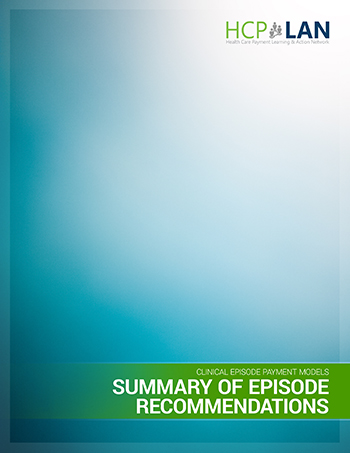


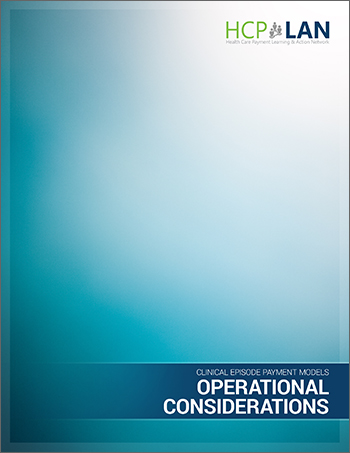
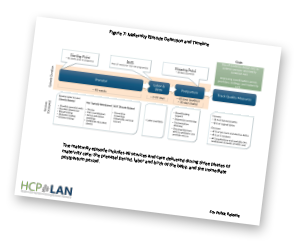
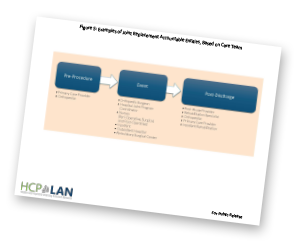
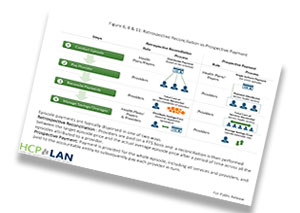
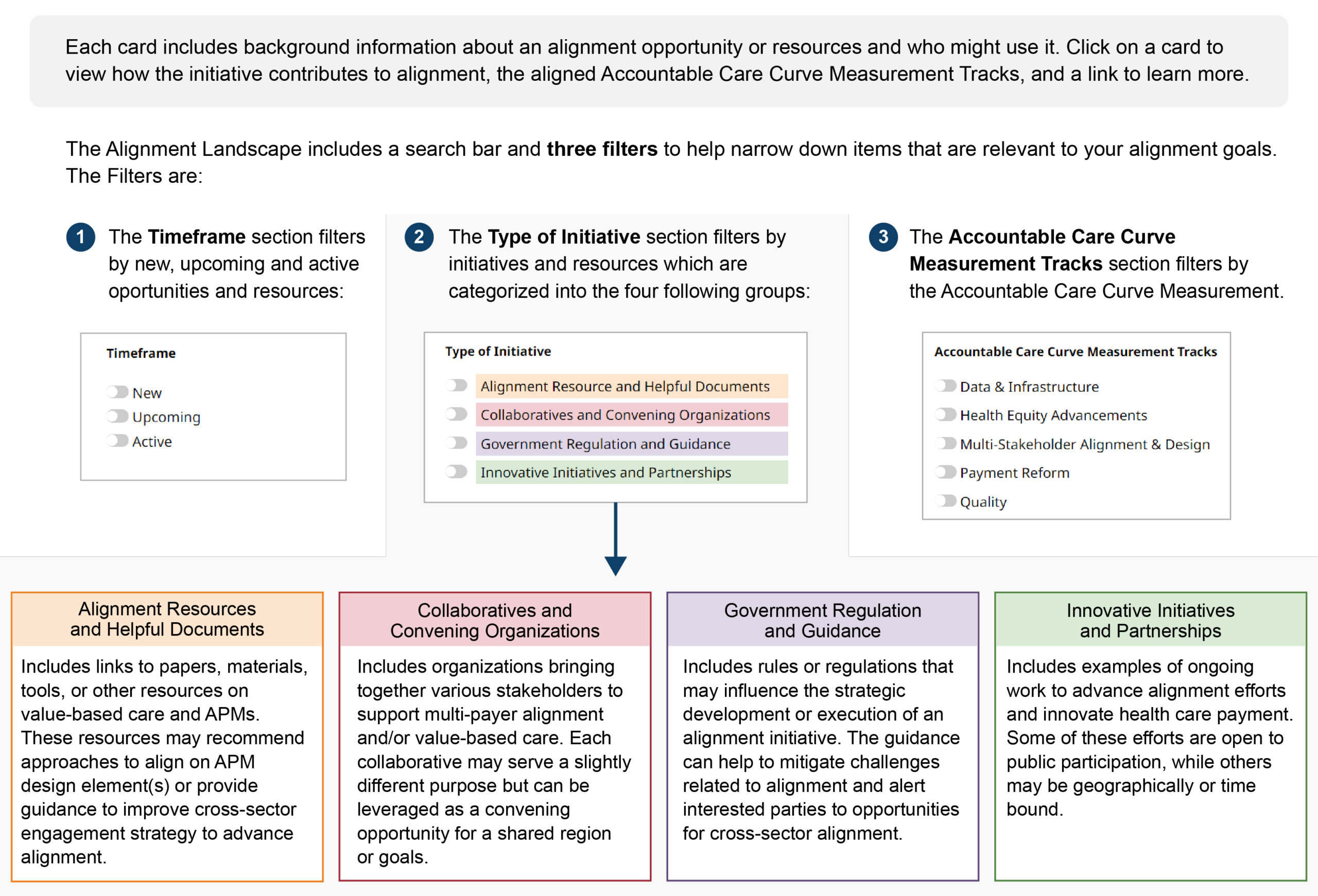



 Emily DuHamel Brower, M.B.A., is senior vice president of clinical integration and physician services for Trinity Health. Emphasizing clinical integration and payment model transformation, Ms. Brower provides strategic direction related to the evolving accountable healthcare environment with strong results. Her team is currently accountable for $10.4B of medical expense for 1.6M lives in Medicare Accountable Care Organizations (ACOs), Medicare Advantage, and Medicaid and Commercial Alternative Payment Models.
Emily DuHamel Brower, M.B.A., is senior vice president of clinical integration and physician services for Trinity Health. Emphasizing clinical integration and payment model transformation, Ms. Brower provides strategic direction related to the evolving accountable healthcare environment with strong results. Her team is currently accountable for $10.4B of medical expense for 1.6M lives in Medicare Accountable Care Organizations (ACOs), Medicare Advantage, and Medicaid and Commercial Alternative Payment Models. Mr. James Sinkoff is the Deputy Executive Officer and Chief Financial Officer for Sun River Health (formerly known as Hudson River HealthCare), and the Chief Executive Officer of Solutions 4 Community Health (S4CH); an MSO serving FQHCs and private physician practices.
Mr. James Sinkoff is the Deputy Executive Officer and Chief Financial Officer for Sun River Health (formerly known as Hudson River HealthCare), and the Chief Executive Officer of Solutions 4 Community Health (S4CH); an MSO serving FQHCs and private physician practices. Victor is the Chief Medical Officer for TennCare, Tennessee’s Medicaid Agency. At TennCare, Victor leads the medical office to ensure quality and effective delivery of medical, pharmacy, and dental services to its members. He also leads TennCare’s opioid epidemic strategy, social determinants of health, and practice transformation initiatives across the agency. Prior to joining TennCare, Victor worked at Evolent Health supporting value-based population health care delivery. In 2013, Victor served as a White House Fellow to the Secretary of Health and Human Services. Victor completed his Internal Medicine Residency at Emory University still practices clinically as an internist in the Veteran’s Affairs Health System.
Victor is the Chief Medical Officer for TennCare, Tennessee’s Medicaid Agency. At TennCare, Victor leads the medical office to ensure quality and effective delivery of medical, pharmacy, and dental services to its members. He also leads TennCare’s opioid epidemic strategy, social determinants of health, and practice transformation initiatives across the agency. Prior to joining TennCare, Victor worked at Evolent Health supporting value-based population health care delivery. In 2013, Victor served as a White House Fellow to the Secretary of Health and Human Services. Victor completed his Internal Medicine Residency at Emory University still practices clinically as an internist in the Veteran’s Affairs Health System. Dr. Brandon G. Wilson, DrPH, MHA (he, him, his) joined Community Catalyst as the Director of the Center for Consumer Engagement in Health Innovation, where he leads the Center in bringing the community’s experience to the forefront of health systems transformation and health reform efforts, in order to deliver better care, better value and better health for every community, particularly vulnerable and historically underserved populations. The Center works directly with community advocates around the country to increase the skills and power they have to establish an effective voice at all levels of the health care system. The Center collaborates with innovative health plans, hospitals and providers to incorporate communities and their lived experience into the design of systems of care. The Center also works with state and federal policymakers to spur change that makes the health system more responsive to communities. And it provides consulting services to health plans, provider groups and other health care organizations to help them create meaningful structures for engagement with their communities.
Dr. Brandon G. Wilson, DrPH, MHA (he, him, his) joined Community Catalyst as the Director of the Center for Consumer Engagement in Health Innovation, where he leads the Center in bringing the community’s experience to the forefront of health systems transformation and health reform efforts, in order to deliver better care, better value and better health for every community, particularly vulnerable and historically underserved populations. The Center works directly with community advocates around the country to increase the skills and power they have to establish an effective voice at all levels of the health care system. The Center collaborates with innovative health plans, hospitals and providers to incorporate communities and their lived experience into the design of systems of care. The Center also works with state and federal policymakers to spur change that makes the health system more responsive to communities. And it provides consulting services to health plans, provider groups and other health care organizations to help them create meaningful structures for engagement with their communities. Tamara Ward is the SVP of Insurance Business Operations at Oscar Health, where she leads the National Network Contracting Strategy and Market Expansion & Readiness. Prior to Oscar she served as VP of Managed Care & Network Operations at TriHealth in Southwest Ohio. With over 15 years of progressive health care experience, she has been instrumental driving collaborative payer provider strategies, improving insurance operations, and building high value networks through her various roles with UHC and other large provider health systems. Her breadth and depth of experience and interest-based approach has allowed her to have success solving some of the most complex issues our industry faces today. Tam is passionate about driving change for marginalized communities, developing Oscar’s Culturally Competent Care Program- reducing healthcare disparities and improving access for the underserved population. Tamara holds a B.A. from the University of Cincinnati’s and M.B.A from Miami University.
Tamara Ward is the SVP of Insurance Business Operations at Oscar Health, where she leads the National Network Contracting Strategy and Market Expansion & Readiness. Prior to Oscar she served as VP of Managed Care & Network Operations at TriHealth in Southwest Ohio. With over 15 years of progressive health care experience, she has been instrumental driving collaborative payer provider strategies, improving insurance operations, and building high value networks through her various roles with UHC and other large provider health systems. Her breadth and depth of experience and interest-based approach has allowed her to have success solving some of the most complex issues our industry faces today. Tam is passionate about driving change for marginalized communities, developing Oscar’s Culturally Competent Care Program- reducing healthcare disparities and improving access for the underserved population. Tamara holds a B.A. from the University of Cincinnati’s and M.B.A from Miami University.


 Dr. Peter Walsh joined the Colorado Department of Health Care Policy and Financing as the Chief Medical Officer on December 1, 2020. Prior to joining HCPF, Dr. Walsh served as a Hospital Field Representative/Surveyor at the Joint Commission, headquartered in Oakbrook Terrace, Illinois.
Dr. Peter Walsh joined the Colorado Department of Health Care Policy and Financing as the Chief Medical Officer on December 1, 2020. Prior to joining HCPF, Dr. Walsh served as a Hospital Field Representative/Surveyor at the Joint Commission, headquartered in Oakbrook Terrace, Illinois.








